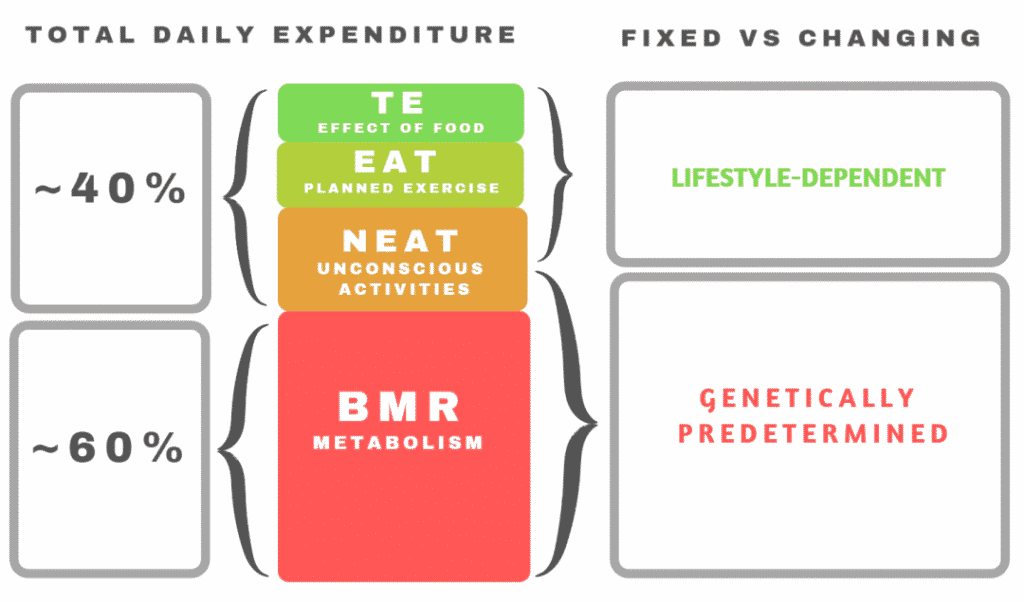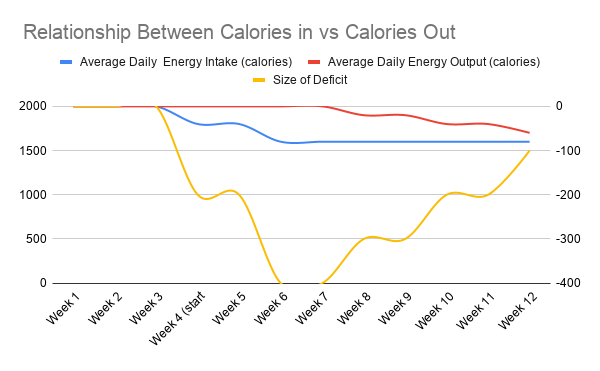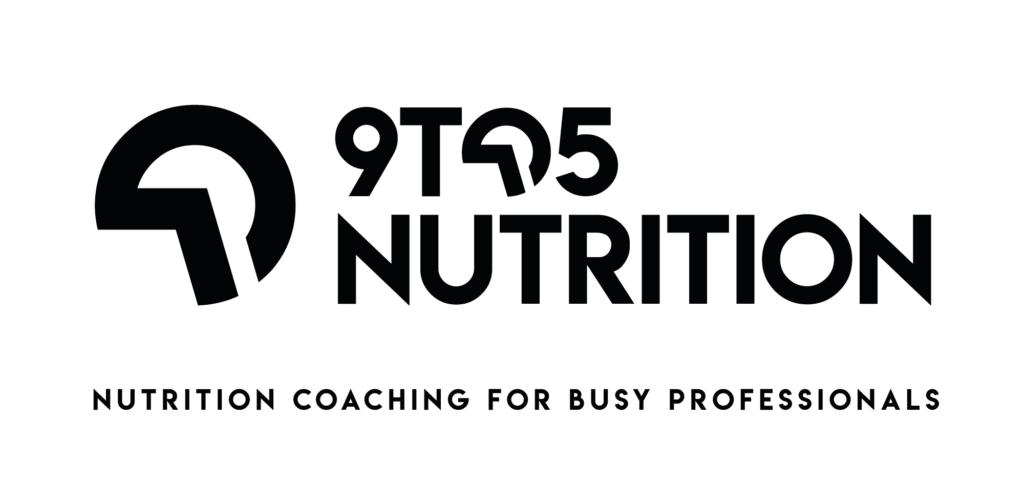- How Much Weight Can You Realistically Lose in 3 Months? - January 14, 2024
- How To Lose 1kg a Week (Guaranteed) - August 20, 2023
- How To Count Calories (or Estimate) and Stay on Track When Eating Out at Restaurants - July 25, 2023
Is weight loss as simple as just calories in vs calories out?
Yes and no.
Ultimately, if you want to lose weight, you need to expend more calories than you eat over a period of time, BUT, the amount and type of calories you eat CAN have an effect on the number of calories you burn.
This makes tracking your calorie output quite tricky which leads a lot of people to get frustrated with tracking calories and give up, thinking that the ‘calories in vs calories out’ approach doesn’t work.
But calorie balance isn;t an approach – it’s a principle.
JUST because you track calories doesn’t mean you’ll lose weight.
Either way, you DO need to be in a calorie deficit (have more calories going out than coming in) to lose weight.
WHAT DOES ‘CALORIES IN’ MEAN?
‘Calories in’ is super simple – this is the food you eat every day.
And EVERYTHING that goes in your mouth (not that) contributes to calories in.
When a lot of people start tracking calories, they’ll make the mistake of leaving out the ‘odd thing’ – no need to track that cup of tea or biscuit.
The problem is, although a tea and biscuit may ‘only’ be 130 calories – that represents 10% of your total daily calories if your goal is only 1300 calories per day.
Going 130 calories over your target each day could definitely be enough to stop you from losing weight, and could even be enough to make you gain weight.
So if you are going to track, track EVERYTHING.
Here are a few other things people conveniently forget to track
- Oil
- Coke
- A few squeezes of mayonaise
- Slice of cake for Karens Birthday
WHAT MAKES UP CALORIES IN?
The majority of what you eat is made up of a mixture of three ‘macronutrients’; protein carbs and fat.
Protein and carbs contain 4 calories per gram, while fat contains 9 calories per gram.
For this reason, the more fat a food contains, the more calories it’ll have.
| MACRONUTRIENT | CALORIES PER GRAM | EXAMPLE FOODS |
| Protein | 4 | chicken breast, white fish, eggs whites |
| Carbs | 4 | oats, rice, potato, fruits, veg |
| Fat | 9 | oil, butter, avocado |
Most foods contain a mix of at least two different macronutrients, but there are a few that contain predominantly one (see above).
Some foods contain a mixture of all three; the best example is milk.
So, if a particular food had 20 grams of protein, 5 grams of fat and 0 grams of carbs, that would mean it had a total of 125 calories
Calories in’ is everything you eat. Everything. That includes teas, coffees, sauces, snacks (yes even the odd biscuit) and cooking oils. If you’re going to track calories, do it accurately and honestly.
WHAT DOES CALORIES OUT MEAN?
The ‘calories out’ part of the equation is a little more complicated, mainly because your ‘calories in’ have a direct but unpredictable effect on calories in calories out.
‘Calories out’ are the calories you use up every day.
A lot of people make the mistake of thinking that ‘calories out’ are JUST the calories you burn from formal exercise like running or cycling.
This is incorrect.
WHAT MAKES UP CALORIES OUT?
Calories out come from four main sources; BMR, NEAT, EAT and TEF.
Each aspect makes up a different proportion of your overall metabolism.

- BMR (Basal Metabolic Rate)
The biggest percentage of your ‘calories out’ come from simply existing.
That’s right, you burn more calories simply being alive (i.e. sitting down all day) than you will from a typical exercise session like half an hour on the treadmill or lifting weights.
The amount of calories you burn at rest is referred to as your ‘basal metabolic rate.
Annoyingly, your basal metabolic rate is quite tricky to calculate accurately AND can change over time, making it a moving target.
Just because this is tricky to calculate, however, doesn’t mean that you shouldn’t bother trying. If you want to know how to calculate your estimated maintenance calories, download my free guide;
The key thing to remember with maintenance calories is that they will fluctuate over time, mainly because your basal metabolic rate fluctuates based on your weight.
Generally speaking, the lighter you are, the lower your basal rate will be.
This is because your body requires less energy to move less mass around.
Think about it – moving a 100kg body from A to B takes more energy than moving a 60kg body from A to B.
For this reason, when you’re embarking on a process of weight loss, it’s super important to track your weight and calorie intake over time. If you reduce your calorie intake and lose weight, that’s awesome, but that rate of weight loss will eventually plateau as your metabolism comes down. Tracking your weight will allow you spot when that plateau happens, and tracking your calories will allow you know how much you’re eating now, and how much you need to reduce your calirie intake by in your want to lose more weight.
- NEAT (Non Exercise Activity Thermogenesis)
NEAT is any form of movement that’s not ‘formal exercise’.
This could be walking from your desk to the kitchen, fidgeting, tapping your foot, stretching, stretching your head, touching your face, or any other micro-movements you make throughout the day.
This level of movement might seem tiny and insignificant, and it probably is, but all these micromovements accumulated over the course of a day, week, and month could add up to thousands of extra calories burned, which could have a significant impact on your weight.
The easiest form of NEAT to control is walking.
Walking requires very little effort, preparation or physical exertion which makes it the perfect form of exercise if you’re looking to lose weight (along with all the other benefits walking has).
Most people would do well to build at least a 30-minute walk into their day.
For the average person, a 30-minute walk will burn around 150 calories.
Do that every day (while keeping everything else the same) and you’ll burn 4,500 calories per month – that’s over 1lb of weight loss!
- EAT (Formal Exercise)
This is what most people think of when they hear ‘calories out’, or calories burned.
The truth is, calories burned through formal exercise make up a very small amount of the overall calories burned throughout the day.
A 30 minute, swim or cycle will burn an average of around 300 calories.
If your BMR (see point 1) is 1800 calories per day, this means that a formal exercise session only increases the TOTAL amount of calories you burn by 17%
Of course, formal exercise sessions that challenge you, make you sweat, and get your heart rate up are great from a health point of view BUT you shouldn’t rely on them if you’re trying to lose weight.
Why?
Formal exercise requires a lot of mental and physical energy, and as mentioned, planning, time, and willpower.
This means you’re highly likely to miss planned sessions.
It’s FAR easier to simply cut 300 calories from your diet, which will have exactly the same effect.
- TEF (Thermic Effect of Food)
Eating food burns calories.
Yep, it’s true.
But here’s the cinch – different macronutrients require different amounts of calories to digest.
The amount of calories used by the digestion of certain foods is called the ‘thermic effect of Food’ (TEF) or ‘diet-induced thermogenesis (DIT). Protein has a higher thermic effect than both carbs and fat.https://www.gigacalculator.com/calculators/thermic-effect-food-calculator.php
Use this calculator to get an idea of how differing diet compositions affect calories out.Thermic Effect of Food Calculatorhttps://web.archive.org/web/20210224221529/https://www.gigacalculator.com/calculators/thermic-effect-food-calculator.php?embed=trueThermic Effect of Food Calculator by
To give you a quick idea of the different levels of DIT in the three macronutrients, I’ll refer to this study
Which found that;
“Reported DIT values for separate nutrients are 0 to 3% for fat, 5 to 10% for carbohydrate, 20 to 30% for protein”
Westerterp, 2004
This means that protein takes more energy to digest than carbs or fat, so of the calories you take in from protein fewer will actually be stored.
| MACRO | MEDIAN DIT | CALORIES EXPENDED PER 100G |
| Protein | 25% | 100 |
| Carbs | 7.5% | 30 |
| Fat | 1.5% | 13.5 |
This is such an important factor that so many people overlook when dieting.
What this essentially means is, the higher percentage of protein you have in your diet, the more calories you’ll burn without having to make any effort.
Let’s say your calorie target was 2000 per day for weight loss, you could theoretically eat 2652 calories of protein and still lose weight.
That’s what a powerful tool protein is for dieting, and your protein intake is something you have total control over.
Moral of the story: EAT MORE PROTEIN.
SO IS WEIGHT LOSS JUST CALORIES IN VS CALORIES OUT?
Yes.
BUT, it’s quite tricky to accurately account for calories in, and VERY difficult to accurately account for calories out.
HOWEVER – this doesn’t override the laws of thermodynamics; if you burn more calories than you take in, you WILL lose weight, whether or not you do or can track it accurately.
The key thing to remember is that calories in can affect calories out, and the type of calories you take in can affect your desire to take in MORE calories.
So, how do calories in affect calories out?
Increases in NEAT
If you eat more, you’ll subconsciously move more.
You probably won’t notice it, but you will.
This could be something as simple as tapping your foot while you’re sitting at your desk, stretching, scratching your head, or just general fidgeting.
All of these things will burn a MINIMAL amount of calories, but over the course of days, weeks and months, these minimal amounts do add up.
Even an additional 50 calories a day is 1500 calories over the course of a month – an entire day’s worth of food for some people!
For some, the effect can be greater- an increase in food intake could even spur you on to take part in more rigorous, formal activity.
As a recent study around NEAT found;
“manipulation of energy balance by means of food intake can exert significant effects on spontaneous physical activity”
Loffelholtz and Birkenfeld, 2018
Studies have found that the increase in NEAT related to increased calorie intake is significant. A 1999 study on 16 people overfed the subjects by 1000 calories per day. This lead to them burning an extra 554 calories per day, 336 calories of which came from increased physical activity
Does this mean that eating more ‘stokes’ the metabolic fire? Yes, but not to the degree where eating a large meal will cancel itself out by increasing your NEAT so much that you’d burn thousands of extra calories.
This does mean however that trying to estimate calories in vs calories head of time is very tricky. Logic would dictate that eating 3500 above your maintenance would result in 1lb of fat gain, however, if the study above is indicative of the entire population, then only around 50% of those calories would be stored, resulting in about 0.5lb of weight loss.
Thermic Effect of food
As discussed earlier, the amount of protein in your diet will also have a direct effect on how many calories you burn.
We know that the diet-induced thermogenesis of protein is higher than that of fat or carbs (i.e. you burn more energy digesting protein than you do carbs or fat), but what does that actually mean in terms of additional calories burned?
This study looked at the differences between meals with high (25% of calories), normal (15% of calories) and low (5%) amounts of protein across a 56-day study.
It found that the high protein meal meant that calories burned from TEF (or DIT) were 15% of total TDEE for the high protein meal and 6% for both the normal and low protein meals

This graph demonstrates that, as protein goes up, so do the number of calories burned through TEF.
Again, this makes calories in vs calories out very difficult to predict ahead of time because you don’t know exactly how much protein you’ll be eating each day.
Satiety (More Protein)
As well as helping to burn more of the calories you take in, protein can also help you stop eating more calories – win-win!
This 2014 study carried out by Ortinau et al on 20 women found that high-protein snacks were far superior at reducing hunger than high-fat snacks. These women were given a controlled breakfast or lunch, a randomly selected snack; either a yogurt (high protein), crackers (high carb), or chocolate (high fat), then an ad-libitum (each as much as you like) dinner.
Participants given the yogurt were found to eat 100 fewer calories at dinner than the cracker or chocolate eaters. They also ate dinner 30 minutes compared to the chocolate eaters and 20 minutes later compared to the cracker eaters.
Another study carried out in 2012 on 27 obese or overweight men compared perceived hunger levels in two groups, one eating a high protein (25% of total calories) and one eating a normal protein (15% of total calories) diet. The high protein group experienced both lower late-night desire to eat and preoccupation with food. The high protein group also experienced greater fullness. This lead to the conclusion that;
“[the data] supports the approach of consuming [a high protein] intake, but not eating more frequently, for improved appetite control and satiety in overweight and obese men during weight loss”
Leidy et al, 2012
While protein is great for satiety, that doesn’t mean you need to eat 17 chicken breasts a day to fill you up. There are plenty of other foods that are filling, without containing a ton of calories. Lean protein (turkey, white fish, chicken), fruit, fibrous veg and beans all have a low-calorie density, i.e. low calories per gram of food. If you want to learn more about low calorie dense foods, read this post.
The takeaway? Eat more protein, veg, fruit, and beans to help you lose more weight, more quickly.
WHAT’S THE SOLUTION?
DON’T try to pre-empt how many calories you’re going to burn or guess how many calories you have burned doing a 30 minute HIIT workout.
Because you’ll get it wrong.
There are FAR too many variables as you can see above.
Instead, take a REACTIVE approach to tracking calories and activity rather than a PROACTIVE approach.
Pick a daily (or weekly) calorie target and stick to it.
Do the same level of activity each week.
Weigh yourself every day. If your weight isn’t going down, you know you need to reduce your calories, increase your activity, or both.
Do that, be patient and trust the process, and don’t worry about calories in vs calories out – you’ll never know exactly how much you’re taking in, or exactly how much you’re expending.
The good news is, if you want to lose weight, you don’t need to know.

Leave a Reply